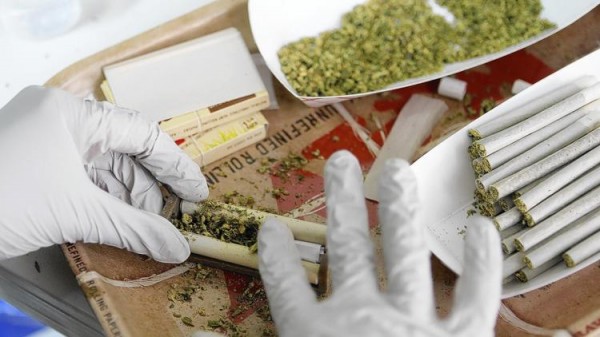At the International Cannabis Business Conference (ICBC) in Portland last month, the atmosphere was that of a winning NASCAR pit crew during the victory lap. Bullish is too weak a word to characterize the 700 vape pen purveyors and cannabis attorneys in attendance (they’d come from as far as Alabama and India). The vibe was bullish but congenial. Inclusive, not cutthroat. On Day Two, an attendee was doing Tai Chi in the Portland Convention Center hallway in between speakers.
This was not lost on the producer of the event, 43-year-old Alex Rogers. “Let’s face it, Oregon’s a relaxed place, a collaborative place,” he said. “You can leave your pretentions and hangups at the door and you won’t get kicked when you do business.” The Oregon business mode, to Rogers, is nothing less than part of “a cultural transformation. If you’re in the cannabis and hemp industry, you will fail if you’re only about the money with no ethics; no consciousness about this plant.” But Rogers, perhaps practicing that ethic himself, quickly added that there was another, bottom-line reason for the touchy-feely aura at an event whose entrance fee was $499. “We’re at the point in the cannabis industry’s evolution where even your competitor’s growth is good for you,” he said.
When not producing one of the traveling ICBC conferences (the next one’s in San Francisco in February), Rogers owns one of Oregon’s largest medical marijuana clinics. He told me he has no problems with profit. In fact, Roger’s win-win economic growth curve for legal cannabis is reason number-one why the passage of Oregon’s Measure 91, which will legalize and regulate all forms of cannabis (including hemp) if voters approve it on November 4, matters to my family, even here in New Mexico. It provides a new Green Standard for how to make legalization work for everyone from families to law enforcement to home cultivators. (The measure had a four-point lead in a September poll, though I predict an eight-point margin of victory.)
Drafted by Portland’s Anthony Johnson and his nationally funded New Approach Oregon team, Measure 91 is, if you want to believe a reporter who was in the conference room when the final draft of the initiative (version #26) was completed nearly a year ago, quite simply the best cannabis regulation model in the world to date. In fairness, Colorado had to do it Colorado’s way, and Washington had to do it Washington’s way. The savvy initiative drafters in those states did what they had to do to tear down the drug war Berlin Wall–they had 70 years of drug war lies to deal with. Oregon is benefitting from seeing what can be done better, and I hope the whole world is watching.
There are a number of key reasons why Measure 91 is the new benchmark. The first reason sticks to the economic benefits theme: revenues (including both tax revenue and an immediate $71 million in annual savings in cannabis enforcement) are expected to be $100 million per year, according to a 2012 study by Harvard economist and Cato Institute fellow Jeffrey Miron.
I’m not the only one who thinks Miron’s estimate is conservative, not just because of the industry growth curve Rogers described at the ICBC, but because a single county I followed in California for a year generates $6 billion annually from its wholesale cannabis crop. Add to that total significant ancillary tax revenue from garden stores, farm equipment retailers and local tourism jobs. Colorado, at $25 million in taxes collected alone and counting, is far ahead of projections for its first, cautious year of retail cannabis sales.
Whatever the total on the ground, the Oregon bounty is divvied in a brilliantly conceived way, both to dampen law enforcement opposition and generate real revenue for the state by eliminating the black market for the world’s number-one harvest.
Fifteen percent of tax revenues go to state police, 10 percent to city police, 10 percent to county law enforcement, 40 percent to education (via the state’s Common School Fund), and 25 percent to agencies dealing with mental health and substance abuse. That breakdown has the former U.S. Attorney for Oregon Kris Olsen, former Oregon state Supreme Court Justice William Riggs, Methodist Minister David Bean, Oregon Congressman Earl Blumenauer and the state’s former director of addiction and mental health services Richard Harris speaking in support of the initiative, not to mention pretty much all regional media and the New York Times.
The health perspective has been getting a good deal of play in the Beaver State. That’s because “Measure 91 will offer education, prevention and treatment,” for people with substance abuse problems, mental health expert Harris said. As for what is being legalized: adults can possess up to eight ounces of cannabis and cultivate up to four plants. Producers will be taxed at $35 per ounce of flowers. (Leaves and immature plants are taxed differently.)
In an earlier interview, Graham Boyd, former director of the American Civil Liberties Union’s Drug Policy Litigation Project, and a fellow who has been involved in cannabis initiatives since 1996, told me that Measure 91 “represents a very strong team of legal minds working on a responsible initiative at a time of growing voter support for our side of the issue.”
That’s why the big boys of drug peace have contributed generously. New Approach has raised $1.5 million both from grassroots efforts and from the usual suspects in successful cannabis regulation campaigns. The late Peter Lewis’ organization and George Soros’ Drug Policy Alliance are both in to the tune of six figures. Opposition has been late and scant, with $150,000 in funding for groups like the state Sherriff’s Association and the Narcotics Enforcement Association; a sign of the times and the strength of the initiative. Indeed, last week one Measure 91 opponent, a county DA named Josh Marquis, told Oregon Public Radio that even he “would not object to a measure that actually said it’s legal to grow, as an adult, say one or two plants at home.” The whole problem is a difference of two plants in a garden? That’s a tepid, and let us hope, a losing strategy.
The truly beneficial reality of the initiative’s nuts and bolts are important, especially as bottom-line arguments for undecided voters who aren’t cannabis aficionados. But for Anthony Johnson, the reason Measure 91 is so important is much more personal. “A good friend of mine in high school had his life ruined by a small cannabis possession arrest,” he told me at the ICBC conference as he manned the booth of the new Oregon Cannabis Industry Association.
Even with Measure 91’s passage, he said, “I’ll continue to work for sensible cannabis laws across the country and across the world until the best policies are in place everywhere. Until no one is judged, let along going to prison for using this plant that’s much safer than alcohol.”
The 37-year-old Johnson will talk to you about the benefits of Measure 91 to Oregon’s tax coffers–he co-wrote the wording. But for him generating revenues for the state from the cannabis and hemp industry is just “the icing on the cake. This is about civil liberties, the best parts of America. About freeing law enforcement to go after dangerous criminals. We’re trying to lead the country to a better future.”
As of the last Gallup poll, close to 60% of Americans nationwide support this valuable crop being snatched from organized crime, and brought into the tax base. Seniors and veterans awakening to the value of aboveground cannabis for economic and health reasons have added to majority support for ending the war on cannabis in once unheard-of places like Kentucky, Texas, Illinois and Florida.
Cannabis legalization (which means its removal from the federal Controlled Substances Act to allow states to regulate it) has, in remarkably rapid fashion, transformed from political liability to campaign rallying cry. Want proof? In California (which will fully legalize cannabis in 2016), cannabis advocates are throwing support to a Republican pro-legalization attorney general candidate over Obama darling but cannabis-silent Kamala Harris, the Democrat.
How did that seemingly counter-intuitive reality come about? Partly through staunch legalization resistance by entrenched California Democrats with strong pharmaceutical company ties. But it’s proved a fragile resistance among the rank and file. Forty percent of Colorado Republicans voted to legalize cannabis in 2012, and this election cycle that awareness is working its way into platforms. Plus, youth turnout, the Holy Grail for Democrats, was up hugely in both Colorado and Washington in the 2012 cannabis legalization elections. That has even traditionally resistant Democratic political camps like the Clintons putting out drug peace feelers.
As a sustainability journalist and solar-powered goat rancher, it is vital to me that the coming cannabis industry (and indeed any industry) prove environmentally sustainable. Unsurprisingly (if you’ve ever spent a minute in Oregon), Measure 91 deals successfully with both of these issues. The home cultivation clause in the initiative is a key one on the sustainability side, to codify the presence of cannabis as part of American outdoor garden, and to prevent big business monopolies and genetic patenting. And the comprehensive addressing of cannabis products like edibles and tinctures pushes cannabis past the final hurdle remaining in front of the true drug peace finish line: social stigma.
This is how I characterize that hurdle: most Americans today, even those who have enjoyed cannabis, if they read a news story about a pilot or teacher who was fired simply because cannabis was in her life, accept it, as they wouldn’t had the pilot or teacher been in possession of a more dangerous beer (or prescribed pharmaceutical). Victory in the drug war is a reversal of that assumption. Be thankful when it’s just legal cannabis and not an opiate, not a violent drunk.
Oregon, in Measure 91’s details (there is no “per se” blood intoxication percentage for cannabis included in Measure 91, for instance), permits us to finally begin to address the importance of updated intoxication laws in this medicated era. It does that by leveling the playing field between cannabis and alcohol, and allowing society to create its sobriety laws based on science, rather than rhetoric. The studies so far indicate that’s going to be bad for drinkers and users of pharmaceuticals, and good for responsible cannabis aficionados. Especially if they haven’t ingested cannabis in the hours before they are driving, flying or teaching–the same expectations we have for folks who enjoy alcohol.
Earlier this year, I asked a Eugene-area state legislator named Floyd Prozanksi about the advent of public venues designed to allow cannabis enjoyment alongside Oregon’s famous (and profitable) microbrew market. “We don’t have a free-for-all with alcohol,” he said. “We have open-container laws, and I can foresee licensed establishments providing cannabis access.” Imagine not being a criminal for choosing, in responsible adult social situations where a beer would be acceptable, an herb rather than alcohol. That, let us pray, becomes reality on November 4 in the Beaver State.
But the absolute best part of Measure 91 is the inclusion of an industrial hemp clause mandating that the state agriculture division issue permits to farmers to cultivate cannabis with less than .3% THC. This is needed. Even though Oregon is one of the 19 states totally in accord with federal law if it permits hemp research farms (as Kentucky, Colorado and Vermont have done this year), it denied the only permit application that came before it in 2014. That hurt the crop the state should most be assisting, and put Oregon a year behind other states that want to profit from what, in Canada, is already a billion-dollar industry. In fairness, one of the agriculture division’s explanations for the hemp application denial was that the state needed time to establish a program, which it says it will in time for planting season in the spring.
That single application was brought forth by Portland attorney Courtney Moran on behalf of eastern Oregon farmer Rick Rutherford. Moran said her motivation for the pro bono work was that, “hemp is truly the greatest renewable resource available to mankind.”
Another former Oregon family farmer, Ryan Basile of Silverton, wants to get back to the land with a hemp crop so badly that he filmed a powerful “Yes on 91” television commercial set against a classic Oregon farm and barn background.
“The hemp clothing you see at the store and the hemp seed you eat comes from abroad,” Basile says in the spot, with a soft-spoken, no-nonsense, I’m-a-rural-Oregonian delivery. “That’s money we can be keeping in Oregon. Farming is a difficult business. With a cash crop like hemp, it can make all the difference.”
Fresh back from visiting four debut Kentucky hemp harvests this week, I know that industrial hemp is going to be even bigger than psychoactive cannabis.You have to start somewhere. Even profitable new (if traditional) crops don’t magically appear in soil. Seems getting said crop in the ground takes more than just farmers, seed and rain. It takes voters, ag bureaucrats and lawyers, too, evidently. With the passage of Measure 91, hemp is going to be healing monoculture-damaged Oregon soil by the thousands of acres while putting family farmers back to work as of 2015. Better still, this is just the birth of an industry that will within twenty years out-earn any other crop in Oregon.
Which brings us back to ICBC producer Rogers’ point on the real dollar value of Oregon’s progressive, un-stressed, optimistic culture. “As a kid activist twenty years ago I used to shout about how hemp can save the planet and people would laugh. Now no one’s laughing. I didn’t realize how right we were. Oregon is ready to capitalize on the truth about this plant.” (Not just Oregon. Washington hemp farmers are poised for a big 2015 as well.) What we’re seeing in the Pacific Northwest is a future for humanity, if these modes catch on, that isn’t bleak. As a patriot, a father, and a cannabis researcher, I can say with confidence that Measure 91 is part and parcel of that journey to a stronger, safer, healthier America.
News Moderator – The General @ 420 MAGAZINE ®
Source: Huffingtonpost.com
Author: Doug Fine
Contact: Contact Us
Website: Why Oregon Is About to Be the Poster Child for How to Legalize and Regulate Marijuana-|-Doug Fine















